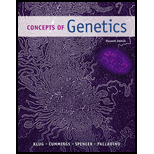
Concept explainers
In a sequence encompassing 99.4 percent of the euchromatic regions of human chromosome 1, Gregory et al. [(2006) Nature 441:315–321] identified 3141 genes.
- (a) How does one identify a gene within a raw sequence of bases in DNA?
- (b) What features of a genome are used to verify likely gene assignments?
- (c) Given that chromosome 1 contains approximately 8 percent of the human genome, and assuming that there are approximately 20,000 genes, would you consider chromosome 1 to be “gene rich”?
(a)
To determine: The ways by which an individual can identify a gene within a raw sequence of bases in DNA.
Introduction: The bioinformatics includes the use of computer hardware and software, mathematics applications to organize, share and analyze data that is related to gene structure, gene sequence and expression; and protein structure and function.
Explanation of Solution
To annotate a gene, an individual identifies gene-regulatory sequences such as promoters, enhancers, and silencers that are found upstream of genes. A person can also identify downstream elements such as termination sequences and in-frame triplet nucleotides that are part of the coding region of the gene. Moreover, 5’ and 3’ splice sites are also used. These splice sites distinguish exons from introns. The polyadenylation sites can also be used in annotation.
Thus, a person can identify a gene from the raw sequence of bases by identifying gene-regulatory sequences and the downstream elements.
(b)
To determine: The characteristics of a genome which are used to verify similar gene assignment.
Introduction: Gene is a unit of DNA that is present on a chromosome. It controls the development of one or more traits. The gene is the basic unit through which genetic information is passed from parent to offspring.
Explanation of Solution
The similarity to other annotated sequences provides an approach to a sequence’s functions, and it confirms a particular genetic assignment. Direct sequencing of cDNAs from various tissues and developmental stages aids in verification.
Thus, direct sequencing of cDNAs of a genome is used to verify similar gene assignment.
(c)
To determine: Whether the chromosome 1 will be considered as “gene rich” provided that it contains approximately 8 % of the human genome and 20,000 genes.
Introduction: The human genome is referred to as the genome of Homo sapiens. The human genome consists of 23 pairs of the chromosome with a total of about 3 billion DNA base pairs.
Explanation of Solution
The 3141 genes identified on chromosome 1which constitute 15.7 % of the total number of genes in the human genome (estimated to be 20,000). As per the given information, chromosome 1 contains 8 % of the human genome and nearly 16 % of the genes; one can say that chromosome 1 is “gene rich”.
Want to see more full solutions like this?
Chapter 21 Solutions
Concepts of Genetics (11th Edition)
- What does the heavy dark line along collecting duct tell us about water reabsorption in this individual at this time? What does the heavy dark line along collecting duct tell us about ADH secretion in this individual at this time?arrow_forwardBiology grade 10 study guidearrow_forwardI would like to see a professional answer to this so I can compare it with my own and identify any points I may have missedarrow_forward
- what key characteristics would you look for when identifying microbes?arrow_forwardIf you had an unknown microbe, what steps would you take to determine what type of microbe (e.g., fungi, bacteria, virus) it is? Are there particular characteristics you would search for? Explain.arrow_forwardavorite Contact avorite Contact favorite Contact ୫ Recant Contacts Keypad Messages Pairing ง 107.5 NE Controls Media Apps Radio Nav Phone SCREEN OFF Safari File Edit View History Bookmarks Window Help newconnect.mheducation.com M Sign in... S The Im... QFri May 9 9:23 PM w The Im... My first.... Topic: Mi Kimberl M Yeast F Connection lost! You are not connected to internet Sigh in... Sign in... The Im... S Workin... The Im. INTRODUCTION LABORATORY SIMULATION Tube 1 Fructose) esc - X Tube 2 (Glucose) Tube 3 (Sucrose) Tube 4 (Starch) Tube 5 (Water) CO₂ Bubble Height (mm) How to Measure 92 3 5 6 METHODS RESET #3 W E 80 A S D 9 02 1 2 3 5 2 MY NOTES LAB DATA SHOW LABELS % 5 T M dtv 96 J: ப 27 כ 00 alt A DII FB G H J K PHASE 4: Measure gas bubble Complete the following steps: Select ruler and place next to tube 1. Measure starting height of gas bubble in respirometer 1. Record in Lab Data Repeat measurement for tubes 2-5 by selecting ruler and move next to each tube. Record each in Lab Data…arrow_forward
 Biology: The Dynamic Science (MindTap Course List)BiologyISBN:9781305389892Author:Peter J. Russell, Paul E. Hertz, Beverly McMillanPublisher:Cengage Learning
Biology: The Dynamic Science (MindTap Course List)BiologyISBN:9781305389892Author:Peter J. Russell, Paul E. Hertz, Beverly McMillanPublisher:Cengage Learning Biology 2eBiologyISBN:9781947172517Author:Matthew Douglas, Jung Choi, Mary Ann ClarkPublisher:OpenStax
Biology 2eBiologyISBN:9781947172517Author:Matthew Douglas, Jung Choi, Mary Ann ClarkPublisher:OpenStax Human Heredity: Principles and Issues (MindTap Co...BiologyISBN:9781305251052Author:Michael CummingsPublisher:Cengage Learning
Human Heredity: Principles and Issues (MindTap Co...BiologyISBN:9781305251052Author:Michael CummingsPublisher:Cengage Learning Concepts of BiologyBiologyISBN:9781938168116Author:Samantha Fowler, Rebecca Roush, James WisePublisher:OpenStax College
Concepts of BiologyBiologyISBN:9781938168116Author:Samantha Fowler, Rebecca Roush, James WisePublisher:OpenStax College BiochemistryBiochemistryISBN:9781305577206Author:Reginald H. Garrett, Charles M. GrishamPublisher:Cengage Learning
BiochemistryBiochemistryISBN:9781305577206Author:Reginald H. Garrett, Charles M. GrishamPublisher:Cengage Learning Biology Today and Tomorrow without Physiology (Mi...BiologyISBN:9781305117396Author:Cecie Starr, Christine Evers, Lisa StarrPublisher:Cengage Learning
Biology Today and Tomorrow without Physiology (Mi...BiologyISBN:9781305117396Author:Cecie Starr, Christine Evers, Lisa StarrPublisher:Cengage Learning





